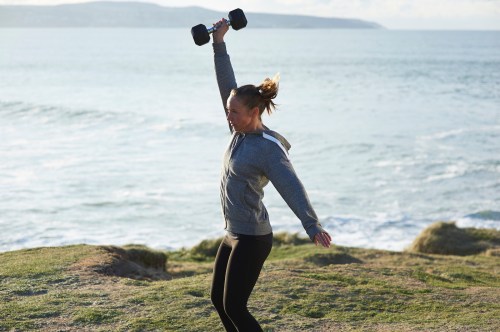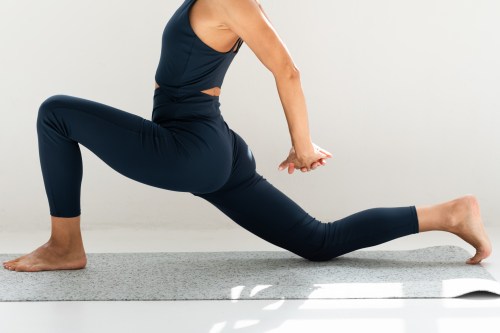The dumbbell power snatch isn’t easy, but it sure is effective. It’s one of the best compound exercises for increasing your strength because it requires you to fire every muscle, from your legs to your glutes to your core to your shoulders. And it’s also an all-star in boosting your agility, balance, and coordination—things that benefit you in and outside the gym.
Experts in This Article
Unfortunately, “power snatch” isn’t the most descriptive name for an exercise. So it’s easy to see why there might be some confusion around the move.
What is a dumbbell power snatch?
This dynamic move is popular in CrossFit circles because it’s “all about balancing explosiveness with control,” says CrossFit athlete and Dymatize fitness expert Dani Speegle. Nope, it’s not exactly a staple of beginner dumbbell workouts.
The gist is that you’re lifting a dumbbell from the floor to your waist and finally above your head, but you’re actually using your lower body and core more than just your arm to achieve that feat.
“You start with your feet at hip distance and the dumbbell between them,” Speegle says. “Squat down in a deadlift-like position and grab the dumbbell from the ground with one hand. Explode upwards with a straight elbow. With the dumbbell now above your hips, your body should be at a full extension. Give it everything you’ve got here: forcefully pull the dumbbell up with your thumb back and your elbow guiding the dumbbell overhead. Once it’s overhead and your elbow is locked out, lower into a squat position to catch the dumbbell’s weight. Stand up with the dumbbell overhead. That’s a rep!”
It sounds long and complex, but it all happens in a flash. Here’s the key to breaking it down.
How to master the dumbbell power snatch in three parts
Kelsey Emmanuel, fitness trainer and founder of Functional Fitness Method, says there are a few different parts to master in order to complete the exercise successfully. In an Instagram post, she breaks down the technique into three steps: a deadlift, high pull, and full dumbbell snatch. Practice the first two steps individually, and only put them both together once you can confidently execute them on their won.
Step 1: Deadlift
- 1.Stand with your feet shoulder-width apart.
- 2.Hold the dumbbell in one arm, keeping your arm straight and close to your body.
- 3.Hinge at the hips and bend forward, keeping your chest up and back flat.
- 4.After the dumbbell touches the ground, bring it right back up to your starting position.
Step 2: High pull
- 1.Next, instead of simply standing back up with the dumbbell after the deadlift, perform a high pull.
- 2.After the dumbbell touches the floor, stand and drive your elbow upward, bringing the dumbbell to the side of your head. Be sure you’re keeping the dumbbell close to your body.
- 3.Return the dumbbell to the floor, then repeat.
Step 3: Dumbbell snatch
- 1.Now, add everything together. As you bring the dumbbell up into the high pull, rotate your elbow, allowing you to extend your arm toward the ceiling with your palm facing forward.
- 2.Reverse the steps to bring the dumbbell back down to the floor.
How to work up to a power snatch
The components above already contain compound movements. You can take things back to basic even further if you’re trying to work up to a power snatch.
“To gear up for performing a dumbbell power snatch, break down the movement and train each aspect separately,” Speegle says. Speegle recommends strengthening the different muscles you engage in the power snatch with the following moves:
- 1.Train glutes and hamstrings with deadlifts, and quads with weighted squats.
- 2.Work on strengthening your back and core through rows, ab work, and back extensions.
- 3.For arms (needed in the dumbbell lift itself), do an arm workout that trains your triceps, including moves like dips and tricep extensions.
You can also check out these beginner dumbbell exercises if you want to get more familiar with working with this versatile strength training tool.
Dumbbell snatch benefits
While it may take some time and practice to master this move, the effort is worth it.
“Because it’s a compound lift, the dumbbell power snatch is going to increase your overall strength, mobility, power, and endurance,” Speegle says. “Think about it— you’re lifting a heavy dumbbell in an explosive movement and you’re practicing control and you’re doing it for multiple reps depending on the weight you choose.”
In terms of the accessories you need to complete the move, the dumbbell power snatch only requires a single piece of equipment, so you can learn how to do it right at home. It’s also a much safer option than a full snatch, which experts say can take years to master.
The effort required to seamlessly lift and control that dumbbell will show up in your strength training gains, too.
What muscles do snatches work?
The power snatch is a true full body movement, engaging your lower body, core, and upper body.
“In the beginning, you’re working glutes and hamstrings,” Speegle says. “As you force the dumbbell overhead, you’re hitting back and triceps. You’re also keeping your core tight the whole time to keep your body stable.”
Power snatch tips
In addition to maintaining good form throughout the different components, there are a few tried and true form consideration to keep in mind that are unique to doing a power snatch. The first concerns the position of the dumbbell.
“To really nail it, keep that dumbbell as close to your body as possible,” Speegle says.
The other tip to keep in mind? Think about the power snatch as if you’re walking a tightrope between generating power and keeping control.
“You want to be explosive, but you also want to maintain stability and balance,” Speegle says. “Remember: you control the dumbbell; the dumbbell does not control you!”
Power snatch variations
Playing with weight, reps, and tempo is the name of the game if you’ve conquered the power snatch and want to challenge yourself further.
“I’ll mix it up by adjusting weight and reps,” Speegle says. “The heavier the weight, the less reps I’ll do. The more reps I do, the lighter the weight.”
But there are also changes to the equipment you can use, and your starting position.
Alternating dumbbell snatch
Perform the dumbbell power snatch as described above, but in an “alternating db snatch,” switch off the arm with which you’re lifting the dumbbell between each rep.
Barbell power snatch
Use a barbell instead of a dumbbell for this move. Rather than picking up a dumbbell with one arm in the center of your body, each arm should grip the barbell a little wider than hip distance, as it would be in an overhead press.
Kettlebell snatch
Instead of beginning the move by deadlifting a dumbbell or barbell, your step one will be doing a kettlebell swing. Kettlebells can be harder to control than dumbbells, so make sure to engage that core and learn the difference between the kettle bell vs. dumbbell first.
Hang power snatch
Rather than starting with a dumbbell (or barbell) on the ground, the hanging power snatch will begin with your weight already lifted off of the ground. How far off the ground is up to you—Speegle says she’ll “start the lift with the barbell either below my knees, above my knees, or mid-thigh.”
Dip power snatch
This variation doesn’t contain the deadlift portion of the move. But because you’re not relying on the power generated in a hinge, your strength comes from a more vertical motion, and ends in a deeper squat.
“If I do a dip power snatch, I start with my arms straight and the barbell just beneath my hip bone,” Speegle says. “My elbows stay straight as I drive the barbell overhead, receive it with bent knees, and then drive it back down to my hips.”
Sign Up for Our Daily Newsletter
Get all the latest in wellness, trends, food, fitness, beauty, and more delivered right to your inbox.
Got it, you've been added to our email list.











